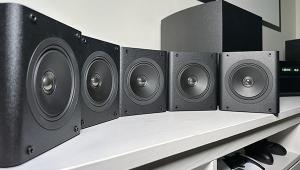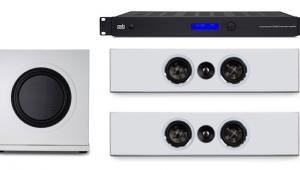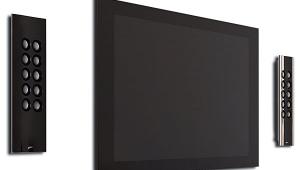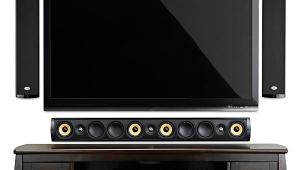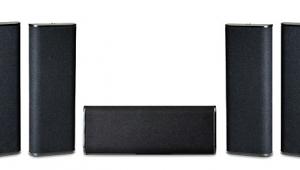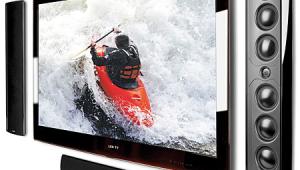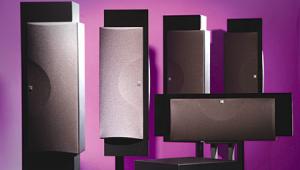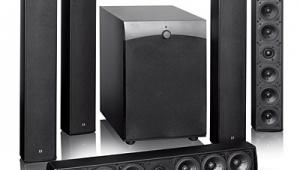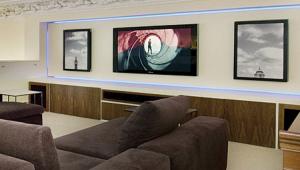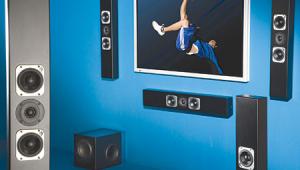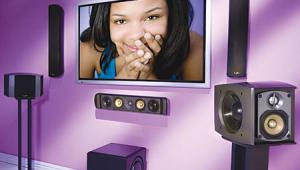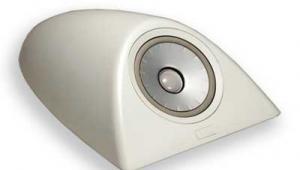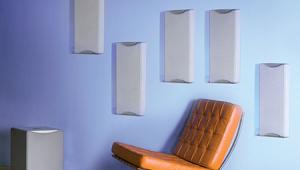KEF T305 Speaker System
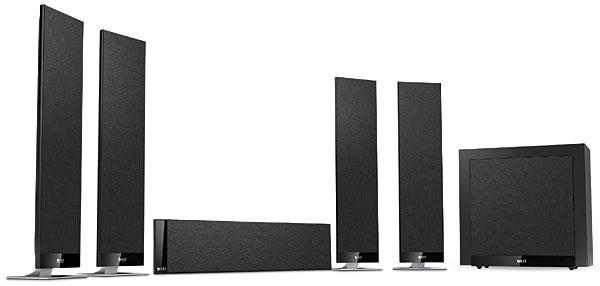
According to a recent (and somewhat controversial) translation of a Dead Sea Scroll fragment, “Thou shalt not alloweth the tail to waggeth thy dog” was the eleventh commandment. Evidently, Moses ran out of room on the tablets and was understandably a little reluctant to ask the Big Guy to “hold that thought” while he scrounged around for another flat rock to chisel on. I think Moses was banking on the fact that he could always make a note in the margins later, but then there was that unfortunate idol-worshiping and throwing-of-the-tablets incident at the bottom of Mt. Sinai. When all was said and done, Moses completely forgot about adding that final admonition.
Despite the fact that it didn’t get carved in stone, not letting the tail wag the dog is still a darn good rule to live by. In less metaphorical terms, don’t let thinner, relatively inconsequential things affect bigger, deeper issues. For example, you should always resist choosing tiny, pitiful-sounding speakers for your home theater system just because your flatpanel HDTV happens to be an inch-and-a-half thick, or a half-inch, or, in the case of a Samsung model introduced last year, 0.3 inches. (They say that’s about the thickness of a number-two pencil, but I haven’t fact-checked them on that.)
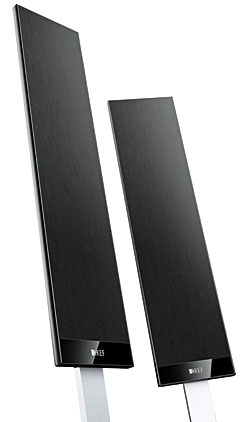 Years ago, stereo and home theater systems used to be big, bulky, manly things. Back then, no sane person even questioned the plainly obvious fact that a big-screen TV required a big cabinet—thus the term big-screen TV. And since the TV was big, the speakers ought to be big, too. In fact, if the speakers weren’t large enough, they’d look silly sitting next to that massive TV cabinet. Today, though, things are different. The whopping popularity of the flat-panel HDTV has pulled the rug (almost literally) out from under the allure of the large speaker. The postmodern assumption is that since the HDTV isn’t taking up a huge amount of floor space, the speakers shouldn’t, either. And, hey, if the image on the screen looks great on a pencil-thin HDTV, then pencil-thin (or
at least Crayola Silly Scents markers–thin) speakers ought to sound good, too, right? Yes, my friends, the world has turned upside down, and the pencil-thin tail of the flat-panel HDTV is wildly wagging the sound-quality doggy on the other end. Will the madness never end?
Years ago, stereo and home theater systems used to be big, bulky, manly things. Back then, no sane person even questioned the plainly obvious fact that a big-screen TV required a big cabinet—thus the term big-screen TV. And since the TV was big, the speakers ought to be big, too. In fact, if the speakers weren’t large enough, they’d look silly sitting next to that massive TV cabinet. Today, though, things are different. The whopping popularity of the flat-panel HDTV has pulled the rug (almost literally) out from under the allure of the large speaker. The postmodern assumption is that since the HDTV isn’t taking up a huge amount of floor space, the speakers shouldn’t, either. And, hey, if the image on the screen looks great on a pencil-thin HDTV, then pencil-thin (or
at least Crayola Silly Scents markers–thin) speakers ought to sound good, too, right? Yes, my friends, the world has turned upside down, and the pencil-thin tail of the flat-panel HDTV is wildly wagging the sound-quality doggy on the other end. Will the madness never end?
Who’s There?
That knocking sound you hear is the UPS guy delivering a single large box containing what KEF calls the T305 system, consisting of four T301 satellites, one T301c center channel, and a T-2 powered subwoofer. The fact that it all—including the subwoofer—came in one box that the relatively skinny UPS guy could manhandle to my doorstep without the use
of a two-wheel dolly was a bit worrisome. After all, I once had to go into therapy for several weeks after I reviewed a particularly awful HTIB system. I’m not sure my insurance will cover another series of treatments. And flatpanel-friendly speaker systems aren’t particularly known for high-performance audio.
My fears soon eased, however. Visually, the T301—and the horizontal version, the T301c—is a jewel of an on-wall speaker. For starters, the T301’s cabinet is only 1.4 inches deep. Sure, that’s not yet in pencil-thin territory, but it’s amazingly shallow for a speaker, especially one from such a pedigreed audio company. (I guess you can’t help but learn a few tricks when you’ve been in the business for 50 years.) The speaker’s height (23.6 inches) and width (5.5 inches) make the T301 proportionally a good visual match for most flat-panel HDTVs.
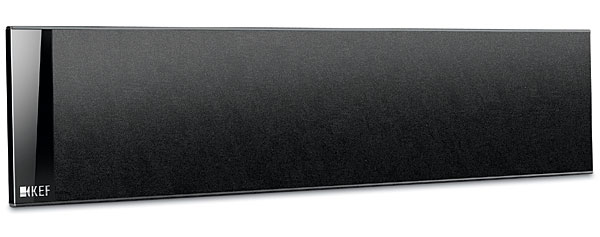
The speakers taper along the back, so that when they’re mounted on the wall, they give the appearance of floating in place. Any lighting in the room bright enough to cast a shadow will subtly highlight the speakers and ironically give them a feeling of depth. Although they come with wall brackets that add virtually nothing to the depth of the mounted speaker, the speakers have keyhole slots on the back that you can use to mount them directly on the wall. KEF also includes shelf stands that lift the speakers up about 2 inches and let you tilt them back up to 5 degrees. The speaker terminals are essentially two holes located in a recessed pocket on the back of the speaker. The holes are small, which means modest-gauge speaker wire is about the thickest you’ll be able to shove into them. Set screws lock the speaker wire into place.
Although KEF voiced the T301/T301c speakers primarily for wall mounting (or near a wall on the shelf stands), some applications will require the use of floor stands located well away from a rear boundary wall. Of course, this situation significantly affects the speaker’s output from around a few hundred hertz and below. KEF’s spiffy Selecta-mount system places filters that make the appropriate adjustments to the crossover network into the stands themselves. Connectors at the top of the stands slide directly into the T301’s terminal inputs, and the speaker wire from your system’s AVR or amplifier gets connected to binding posts at the bottom of the stands. The signal is then routed through the filter circuit automatically. Considering that the vast majority of these systems will be wall-mounted, this isn’t something most people will ever take advantage of. That doesn’t make it any less clever, though.

The Beast Inside the Beauty
There’s more than mere cleverness going on here, and much of the technology derives from things KEF learned in research for its no-holds-barred virtually-no-budget-limit Concept Blade Loudspeaker project. Behind the simple black grilles that cover each of the satellites are a pair of 4.5-inch bass drivers along with a 1-inch rear-vented tweeter. As you might guess, each driver is specially designed for a thincabinet application. The midbass drivers use a twin-layered, flat diaphragm with both radially and circumferentially positioned ribs on the rear surface. The ribs
help to stiffen and brace the diaphragm, and a thin layer of “high elastic modulus material” (that sounds disgustingly bizarre, and I don’t want to know any more about whatever it’s made from)
on the back of the ribs adds even more rigidity that works to eliminate resonance within the driver’s working range. The T301’s flat diaphragm and its unique low-profile surround also help create a front baffle that’s much more smooth and uninterrupted than what you’d find on a speaker with traditional cone drivers;
the smoother and flatter the
front baffle, the less it affects the tweeter’s output. KEF says the 1-inch tweeter is much larger than the typical 19-mm tweeter that’s used in lots of small/slim speakers. In addition to being rear-vented—a design that helps reduce distortion caused by the back wave off the dome—the tweeter sits behind what KEF calls a tangerine wave guide that’s supposed to increase sensitivity and control dispersion at the upper frequencies.

